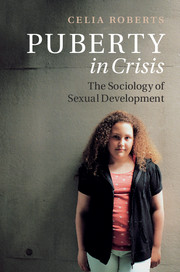Book contents
- Frontmatter
- Dedication
- Contents
- List of figures
- Acknowledgements
- 1 Puberty in crisis? Sex, reproduction and the loss of future
- 2 Articulating findings, feelings and figurations: methods and approaches
- 3 Telling histories: the scientific study of puberty
- 4 Defining early onset puberty: troubling findings about sexual development
- 5 Causes and explanations: genes, fat, toxins and families
- 6 Consequences of early development: sex, drugs and shortness
- 7 Treatments: pharmaceuticals, sex and suffering
- Conclusion: Folding puberty differently: changing findings, feeling and figurations
- References
- Index
3 - Telling histories: the scientific study of puberty
Published online by Cambridge University Press: 05 August 2015
- Frontmatter
- Dedication
- Contents
- List of figures
- Acknowledgements
- 1 Puberty in crisis? Sex, reproduction and the loss of future
- 2 Articulating findings, feelings and figurations: methods and approaches
- 3 Telling histories: the scientific study of puberty
- 4 Defining early onset puberty: troubling findings about sexual development
- 5 Causes and explanations: genes, fat, toxins and families
- 6 Consequences of early development: sex, drugs and shortness
- 7 Treatments: pharmaceuticals, sex and suffering
- Conclusion: Folding puberty differently: changing findings, feeling and figurations
- References
- Index
Summary
I don't want to inherit these violent histories …; that's why I have to tell them.
(Haraway 2003: 82)Today puberty is widely understood to be both itself in crisis and indicative of a broader environmental and/or social crisis. Children's bodies are said to be changing at previously unknown rates with as yet unclear but potentially dramatic effects. Such assessments are based on historical comparison. This chapter narrates a history of scientific studies of physiological sexual development, articulating how puberty has been defined and made in modern science and medicine. As outlined in the previous chapter, I rely on an understanding of scientific work as culturally, geographically and historically situated practice: building on a critical science studies tradition, ‘science’ and ‘biomedicine’ are understood as activities involving humans and non-humans that enact bodies and worlds. A wide range of discourses and activities constitute the apparatuses of technoscience: as embodied actors working with and through a range of materials, ideas and feelings, scientists and clinicians make bio-psycho-social worlds through their work. Telling stories about scientific history is one route to exploring the articulations of differences that are simultaneously material and conceptual or ‘material-semiotic’ to use Donna Haraway's term.
Since late modern times, puberty has been figured in Euro-American cultures as a difficult period in a person's life, fraught with emotional and physical risk and requiring careful negotiation. From the mid nineteenth century, such management increasingly came to involve medical knowledge, with advice manuals written by doctors suggesting both spiritual and physical techniques to assist young men and women to weather the transition between childhood and adulthood (Moran 2000: ch. 1). Puberty was thought to consume immense reserves of nervous energy, leaving girls in particular in a vulnerable state, unable, for example, to participate in education (see for example, Maudsley 1874).
- Type
- Chapter
- Information
- Puberty in CrisisThe Sociology of Early Sexual Development, pp. 51 - 90Publisher: Cambridge University PressPrint publication year: 2015



